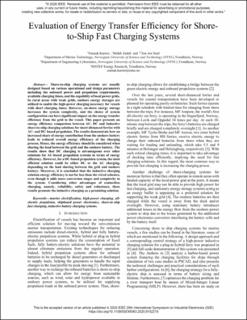| dc.contributor.author | Karimi, Siamak | |
| dc.contributor.author | Zadeh, Mehdi | |
| dc.contributor.author | Suul, Jon Are Wold | |
| dc.date.accessioned | 2021-02-19T09:41:20Z | |
| dc.date.available | 2021-02-19T09:41:20Z | |
| dc.date.created | 2020-11-16T19:48:52Z | |
| dc.date.issued | 2020 | |
| dc.identifier.citation | Proceedings of the IEEE International Symposium on Industrial Electronics. 2020, 1271-1277. | en_US |
| dc.identifier.issn | 2163-5145 | |
| dc.identifier.uri | https://hdl.handle.net/11250/2729121 | |
| dc.description.abstract | Shore-to-ship charging systems are usually designed based on various operational and design parameters including the onboard power and propulsion requirements, available charging times, and the capability of local power grids. In rural areas with weak grids, onshore energy storages are utilized to enable the high-power charging necessary for vessels with short charging times. However, on-shore energy storage increases the system complexity, and the choice of system configuration can have significant impact on the energy transfer efficiency from the grid to the vessel. This paper presents an energy efficiency comparison between AC, DC and Inductive shore-to-ship charging solutions for short-distanced ferries with AC- and DC-based propulsion. The results demonstrate how an increased share of energy contribution from the onshore battery leads to reduced overall energy efficiency of the charging process. Hence, the energy efficiency should be considered when sharing the load between the grid and the onshore battery. The results show that DC charging is advantageous over other solutions for AC-based propulsion systems in terms of energy efficiency. However, for a DC-based propulsion system, the most efficient solution could be either DC or the AC charging, depending on the load sharing between the grid and onshore battery. Moreover, it is concluded that the inductive charging solution energy efficiency is not far less than the wired schemes, even though it adds more conversion stages and complexity to the system. Considering other advantages of contactless charging, namely, reliability, safety and robustness, these results promote the inductive charging as a promising solution. | en_US |
| dc.language.iso | eng | en_US |
| dc.publisher | Institute of Electrical and Electronics Engineers (IEEE) | en_US |
| dc.subject | DC Power Systems | en_US |
| dc.subject | DC Power Systems | en_US |
| dc.subject | Batterilading | en_US |
| dc.subject | Battery Charging | en_US |
| dc.subject | Maritime elektriske kraftsystemer | en_US |
| dc.subject | Marine Power System | en_US |
| dc.subject | Kraftelektronikk | en_US |
| dc.subject | Power Electronics | en_US |
| dc.subject | Hybrid Electric Ships | en_US |
| dc.subject | Hybrid Electric Ships | en_US |
| dc.title | Evaluation of Energy Transfer Efficiency for Shore-to-Ship Fast Charging Systems | en_US |
| dc.type | Peer reviewed | en_US |
| dc.type | Journal article | en_US |
| dc.description.version | acceptedVersion | en_US |
| dc.subject.nsi | VDP::Elektrotekniske fag: 540 | en_US |
| dc.subject.nsi | VDP::Electro-technical sciences: 540 | en_US |
| dc.subject.nsi | VDP::Elektrotekniske fag: 540 | en_US |
| dc.subject.nsi | VDP::Electro-technical sciences: 540 | en_US |
| dc.source.pagenumber | 1271-1277 | en_US |
| dc.source.journal | Proceedings of the IEEE International Symposium on Industrial Electronics | en_US |
| dc.identifier.doi | 10.1109/ISIE45063.2020.9152219 | |
| dc.identifier.cristin | 1848544 | |
| dc.relation.project | Norges forskningsråd: 237917 | en_US |
| dc.description.localcode | © 2020 IEEE. Personal use of this material is permitted. Permission from IEEE must be obtained for all other uses, in any current or future media, including reprinting/republishing this material for advertising or promotional purposes, creating new collective works, for resale or redistribution to servers or lists, or reuse of any copyrighted component of this work in other works. | en_US |
| cristin.ispublished | true | |
| cristin.fulltext | postprint | |
| cristin.qualitycode | 1 | |
